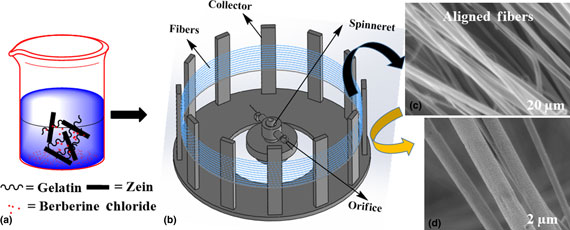Crossref Citations
This article has been cited by the following publications. This list is generated based on data provided by
Crossref.
Jahangirian, Hossein
Azizi, Susan
Rafiee-Moghaddam, Roshanak
Baratvand, Bahram
and
Webster, Thomas J.
2019.
Status of Plant Protein-Based Green Scaffolds for Regenerative Medicine Applications.
Biomolecules,
Vol. 9,
Issue. 10,
p.
619.
Mamidi, Narsimha
González-Ortiz, Aldo
Lopez Romo, Irasema
and
V. Barrera, Enrique
2019.
Development of Functionalized Carbon Nano-Onions Reinforced Zein Protein Hydrogel Interfaces for Controlled Drug Release.
Pharmaceutics,
Vol. 11,
Issue. 12,
p.
621.
Ferraris, Sara
Spriano, Silvia
Scalia, Alessandro Calogero
Cochis, Andrea
Rimondini, Lia
Cruz-Maya, Iriczalli
Guarino, Vincenzo
Varesano, Alessio
and
Vineis, Claudia
2020.
Topographical and Biomechanical Guidance of Electrospun Fibers for Biomedical Applications.
Polymers,
Vol. 12,
Issue. 12,
p.
2896.
Mamidi, Narsimha
Velasco Delgadillo, Ramiro
Gonzáles Ortiz, Aldo
and
Barrera, Enrique
2020.
Carbon Nano-Onions Reinforced Multilayered Thin Film System for Stimuli-Responsive Drug Release.
Pharmaceutics,
Vol. 12,
Issue. 12,
p.
1208.
Pérez-Guzmán, Carlos Joaquín
and
Castro-Muñoz, Roberto
2020.
A Review of Zein as a Potential Biopolymer for Tissue Engineering and Nanotechnological Applications.
Processes,
Vol. 8,
Issue. 11,
p.
1376.
Kanu, Nand Jee
Gupta, Eva
Vates, Umesh Kumar
and
Singh, Gyanendra Kumar
2020.
Electrospinning process parameters optimization for biofunctional curcumin/gelatin nanofibers.
Materials Research Express,
Vol. 7,
Issue. 3,
p.
035022.
Jee Kanu, Nand
Gupta, Eva
Sutar, Venkateshwara
Kumar Singh, Gyanendra
and
Kumar Vates, Umesh
2021.
Nanofibers - Synthesis, Properties and Applications.
Olkhov, Anatoliy
Alexeeva, Olga
Konstantinova, Marina
Podmasterev, Vyacheslav
Tyubaeva, Polina
Borunova, Anna
Siracusa, Valentina
and
Iordanskii, Alex L.
2021.
Effect of Glycero-(9,10-trioxolane)-trialeate on the Physicochemical Properties of Non-Woven Polylactic Acid Fiber Materials.
Polymers,
Vol. 13,
Issue. 15,
p.
2517.
Sharma, Ameya
Puri, Vivek
Kumar, Pradeep
Singh, Inderbir
and
Huanbutta, Kampanart
2021.
Development and Evaluation of Rifampicin Loaded Alginate–Gelatin Biocomposite Microfibers.
Polymers,
Vol. 13,
Issue. 9,
p.
1514.
Bonferoni, Maria Cristina
Caramella, Carla
Catenacci, Laura
Conti, Bice
Dorati, Rossella
Ferrari, Franca
Genta, Ida
Modena, Tiziana
Perteghella, Sara
Rossi, Silvia
Sandri, Giuseppina
Sorrenti, Milena
Torre, Maria Luisa
and
Tripodo, Giuseppe
2021.
Biomaterials for Soft Tissue Repair and Regeneration: A Focus on Italian Research in the Field.
Pharmaceutics,
Vol. 13,
Issue. 9,
p.
1341.
Mamidi, Narsimha
Delgadillo, Ramiro Manuel Velasco
and
Castrejón, Javier Villela
2021.
Unconventional and facile production of a stimuli-responsive multifunctional system for simultaneous drug delivery and environmental remediation.
Environmental Science: Nano,
Vol. 8,
Issue. 7,
p.
2081.
Mamidi, Narsimha
Delgadillo, Ramiro Manuel Velasco
and
González-Ortiz, Aldo
2021.
Engineering of carbon nano-onion bioconjugates for biomedical applications.
Materials Science and Engineering: C,
Vol. 120,
Issue. ,
p.
111698.
Song, Jingru
Sun, Cuixia
Gul, Khalid
Mata, Analucia
and
Fang, Yapeng
2021.
Prolamin‐based complexes: Structure design and food‐related applications.
Comprehensive Reviews in Food Science and Food Safety,
Vol. 20,
Issue. 2,
p.
1120.
Sharma, Shubham
Sudhakara, P.
Singh, Jujhar
Ilyas, R. A.
Asyraf, M. R. M.
and
Razman, M. R.
2021.
Critical Review of Biodegradable and Bioactive Polymer Composites for Bone Tissue Engineering and Drug Delivery Applications.
Polymers,
Vol. 13,
Issue. 16,
p.
2623.
Dede, Sercan
Sadak, Omer
Didin, Mustafa
and
Gunasekaran, Sundaram
2022.
Basil oil-loaded electrospun biofibers: Edible food packaging material.
Journal of Food Engineering,
Vol. 319,
Issue. ,
p.
110914.
García-Valderrama, Elsy J.
Mamidi, Narsimha
Antunes-Ricardo, Marilena
Gutiérrez-Uribe, Janet A.
Del Angel-Sanchez, Karina
and
Elías-Zúñiga, Alex
2022.
Engineering and Evaluation of Forcespun Gelatin Nanofibers as an Isorhamnetin Glycosides Delivery System.
Pharmaceutics,
Vol. 14,
Issue. 6,
p.
1116.
Mamidi, Narsimha
García, Rubén Gutiérrez
Martínez, José Daniel Hernández
Briones, Camila Martínez
Martínez Ramos, Andrea Michelle
Tamez, María Fernanda Leal
Del Valle, Braulio González
and
Segura, Francisco Javier Macias
2022.
Recent Advances in Designing Fibrous Biomaterials for the Domain of Biomedical, Clinical, and Environmental Applications.
ACS Biomaterials Science & Engineering,
Vol. 8,
Issue. 9,
p.
3690.
Li, Zhen
Mei, Shunqi
Dong, Yajie
She, Fenghua
Li, Chengpeng
Li, Yongzhen
and
Kong, Lingxue
2022.
Oxidized Chitosan-Tobramycin (OCS-TOB) Submicro-Fibers for Biomedical Applications.
Pharmaceutics,
Vol. 14,
Issue. 6,
p.
1197.
Khalili, Shahla
Ghane, Nazanin
Nouri Khorasani, Saied
Heydari, Fariba
Atwal, Arjan
and
Davoodi, Pooya
2022.
Cytocompatibility and Antibacterial Properties of Coaxial Electrospun Nanofibers Containing Ciprofloxacin and Indomethacin Drugs.
Polymers,
Vol. 14,
Issue. 13,
p.
2565.
Mitra, Souradeep
Mateti, Tarun
Ramakrishna, Seeram
and
Laha, Anindita
2022.
A Review on Curcumin-Loaded Electrospun Nanofibers and their Application in Modern Medicine.
JOM,
Vol. 74,
Issue. 9,
p.
3392.



